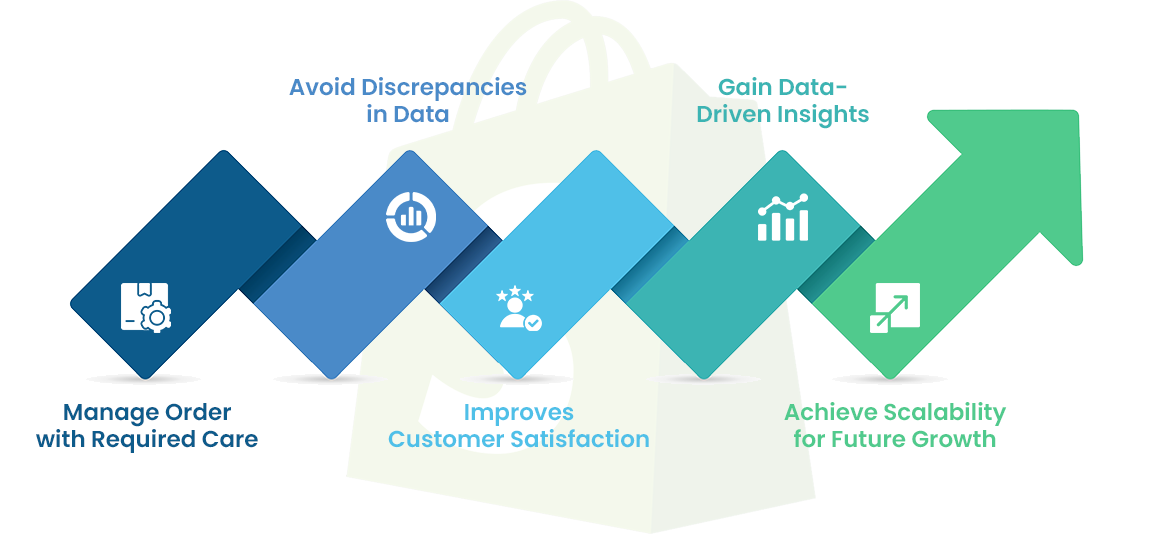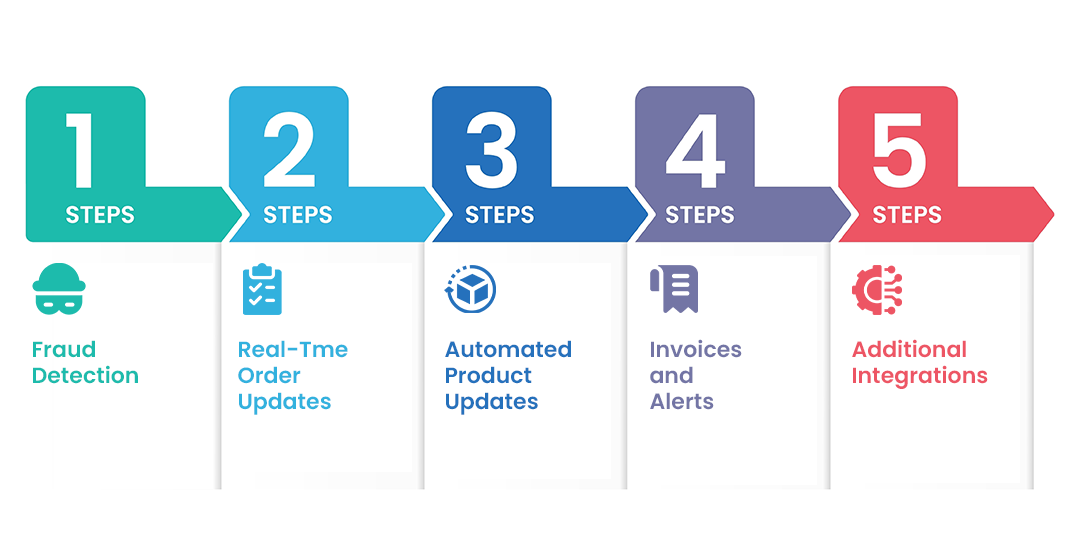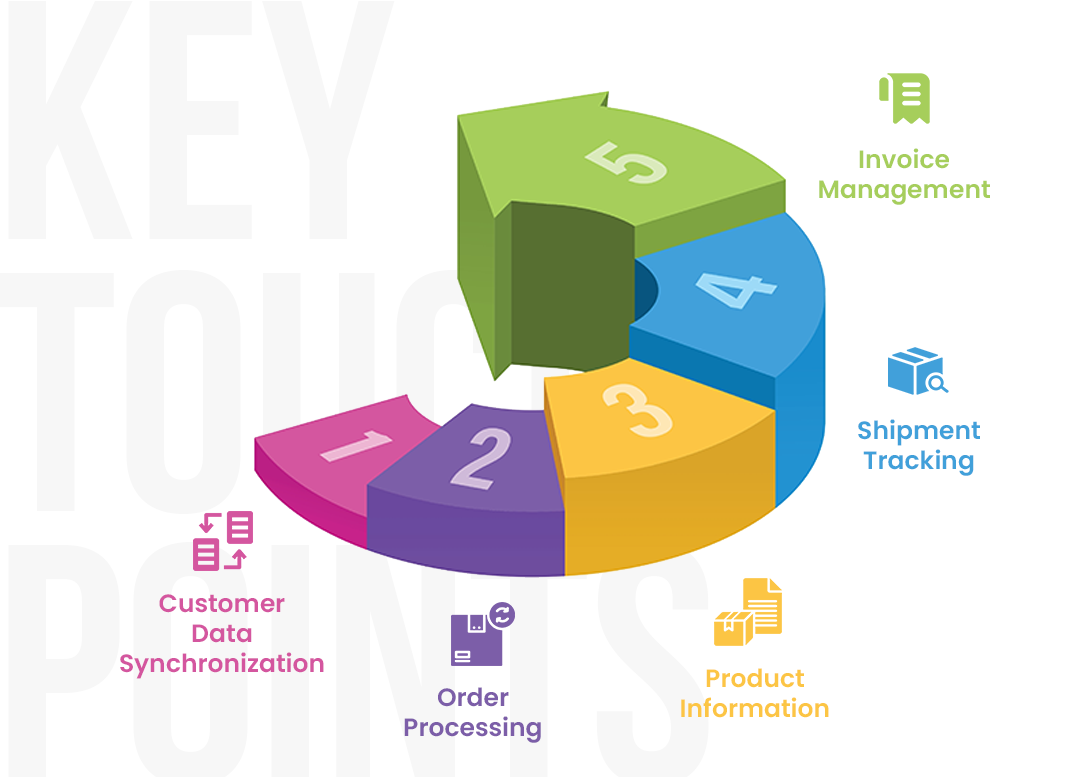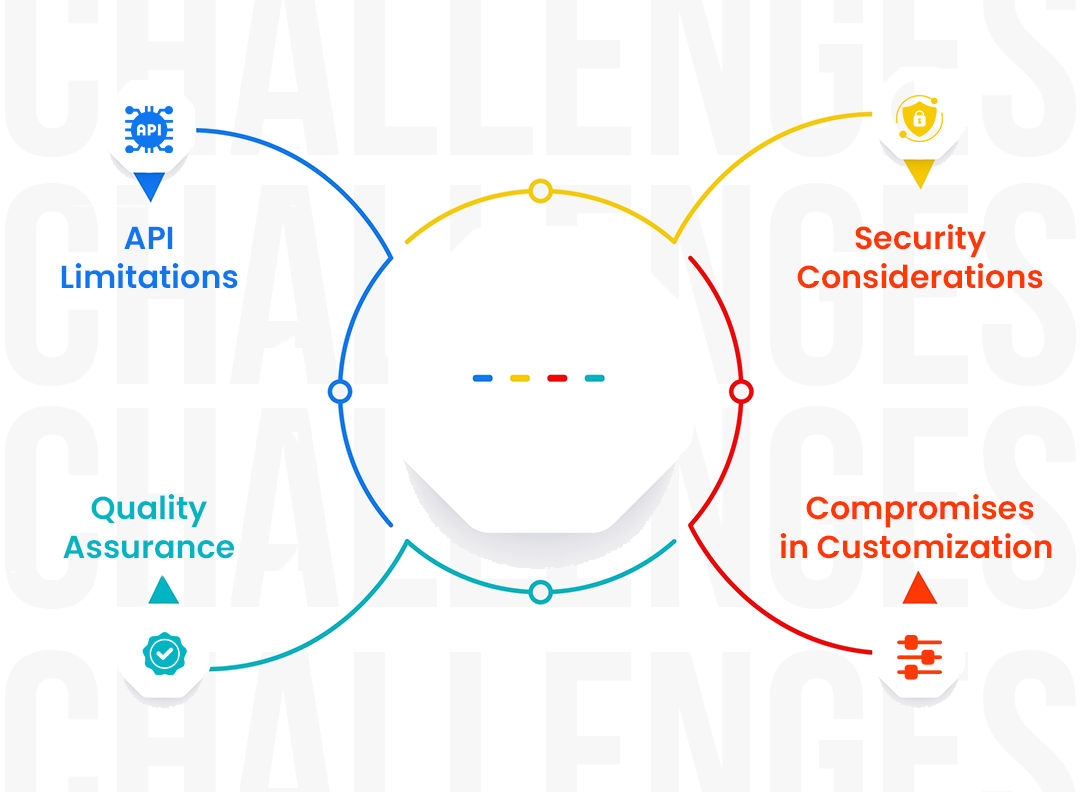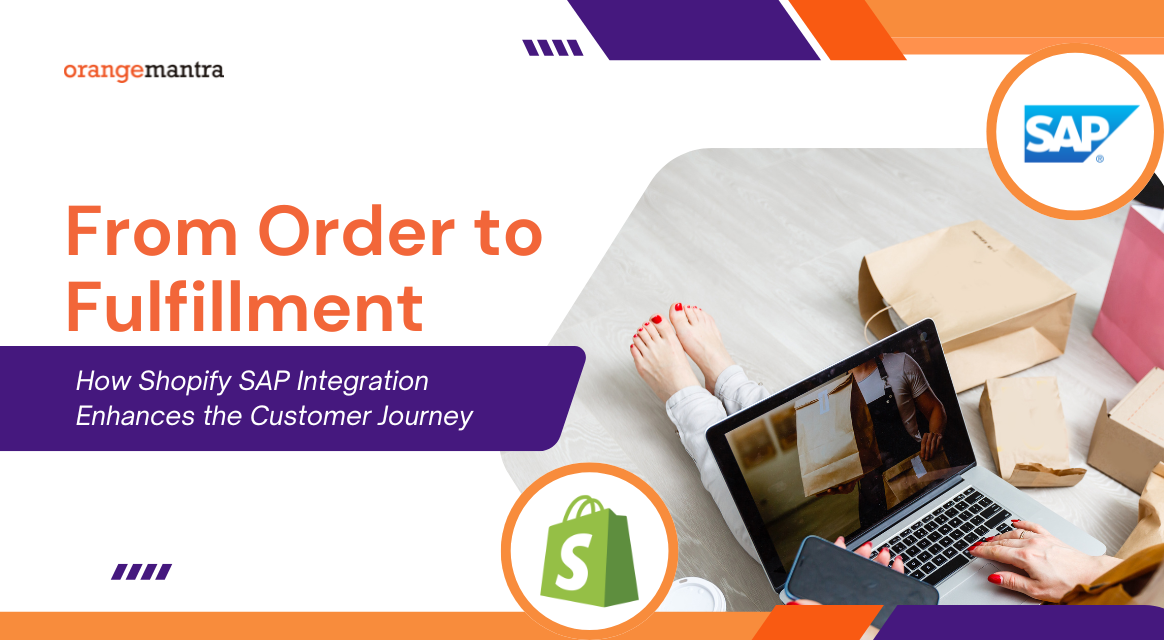
Here’s what you will learn:
There’s a moment every growing eCommerce brand reaches.
You’ve got a Shopify store that’s doing well, orders are coming in, and customers seem happy. But behind the scenes, things start to feel… scattered.
Inventory updates are delayed. Invoices get missed. Your team spends more time cleaning up data than actually using it.
It’s not that your systems are broken – it’s just that they’re not talking to each other.
That’s where integration comes in.
Specifically, integrating Shopify with SAP. Not as a big, shiny tech upgrade but as a quiet, powerful shift in how your operations work together.
When your eCommerce front-end and your ERP back-end are in sync, a lot starts to fall into place. Orders move faster. Teams get aligned. You stop guessing and start seeing.
This article breaks down why that integration matters, what benefits it brings, and the kind of transformation it quietly sets in motion – one that’s less about tech, and more about working smarter, scaling better, and giving your customers the experience they actually came for.
Table of Contents
A Quick Look at Stats
The pressure on eCommerce businesses is real as the environment is becoming more competitive and complex. Steps like Shopify SAP integration are strategic moves you can take to lead the market.
- Shopify now powers over 4 million active stores in more than 175 countries.
- In 2023 alone, Shopify processed a Gross Merchandise Volume (GMV) of $235.9 billion.
- SAP customers contribute to 84% of total global commerce, which shows just how deeply embedded SAP is in the backbone of worldwide business operations.
- The ERP software market is projected to reach $123.41 billion by 2030.
Reasons Why You Need Shopify Integration with SAP
Manage Order with Required Care
The first and foremost reason is to eliminate duplicate data entry. This is achieved as the integration automates data flow between Shopify and SAP. This not only prevents data redundancy but also data mismatches. The orders are already automatically reflected into your ERP system for more streamlined fulfillment.
Avoid Discrepancies in Data
Another important reason is to avoid over or underselling of products. The integration brings both the platforms on the same pages achieving real-time visibility into stock levels. This helps prevent customer dissatisfaction caused due to order delays or order rejection.
Improves Customer Satisfaction
As the customer-facing Shopify eCommerce development and business-facing SAP ERP are integrated, this expedites the order processing and achieves better communication with the customer as well as within and amongst teams. As a result, you achieve timely fulfillment and a better customer experience, and we have already discussed inventory updates and their effect on customers.
Gain Data-Driven Insights for the Right Decisions
Combined together, Shopify and SAP share data which helps businesses analyze customer behavior and key performance indicators (KPIs). This brings some deep and meaningful insights to make a huge difference whether it is to serve customers or to overcome tough competition.
This eCommerce platform development and integration with SAP bring some deep and meaningful insights to make a huge difference whether it is to serve customers or to overcome tough competition.
Achieve Scalability for Future Growth
This is the most critical aspect that many businesses overlook. By overcoming the challenges to order handling and the complexities of operations, the integration prepares your business for growth and expansion. It enables you to handle more orders and operate with more smoothness, it lays a foundation for scaling.
5 Benefits of Shopify SAP Integration
Shopify integration with SAP brings some unique benefits that directly contribute to business growth and competitiveness.
From ensuring security, collaboration to even adding specialized features to support your specific business needs, it does it all.
Fraud Identification
SAP integration with Shopify brings real-time monitoring of orders and automatically detects high-risk orders thanks to SAP’s algorithms that analyze transaction data in real-time.
Its advanced analytics and fraud detection features scan through the huge pile of orders and transactions, identify patterns, flag suspicious activities, and send self-activated alerts to admins.
The suspicious activities can be any unusual order volumes, billing discrepancy and suspicious shipping addresses, or even the risky payment methods. This goes a long way to preventing fraudulent transactions with machine-level precision.
Real-Time Order Updates
Post ensuring security with the above-mentioned fraud detection method, the topmost benefit of integration that we think is the synchronized order fulfillment process. The integration not only syncs order statuses but all other related data such as pricing, and inventory levels and changes.
This brings improvement on both sides. On the one hand the customer is satisfied with the timely delivery and the overall shopping experience. On the other hand, the employees and departments are motivated due to ease of operation and the improved sense of clarity.
Automated Product Updates
Talking about synchronization, one of the sticky points for eCommerce development company has been the mismatches in product details such as SKU, prices, and inventory between the platforms.
As the integration of the two platforms achieve automated updating of all these necessary details, it prevents data mismatches and brings uniformity across platforms and departments. This leads to better collaboration and coordination throughout the organization.
Invoices and Alerts
Shopify integration syncs all order-related data such as payments and invoices. So, as soon as an order is placed on Shopify, its corresponding invoice gets automatically generated in SAP with all the relevant payment details.
Also, the Shopify SAP integration helps in real-time monitoring for any payment failures or discrepancies.
For e.g. in case of failed transaction detection, the system triggers an automatic alert. This notifies the admin for immediate action and leads to ensuring smooth financial operations with negligible errors.
Additional Integrations
This one benefit can prove to be very competitive, if used smartly. See, Shopify SAP integration supports additional plugins and services.
This means you can add any functionality and feature to your business with the solid backing of both of these platforms. For example, if you want to automate invoice generation, you can add this functionality to streamline your billing processes.
Similarly, if you have multiple Shopify stores, a multi-store management will allow you to manage all these Shopify stores from a single SAP system, fascinating isn’t it.
This will centralize your data for inventory, orders, and customer information and will ease your operational hassle for high efficiency and scalability.
5 Key Touchpoints for Shopify SAP Integration
The integration between Shopify and SAP ERP, impact different aspects of your business.
Although we have covered these in the above section in fragment, here we will dedicatedly discuss how integration modifies your business for the good.
Customer Data Synchronization
Starting with customers, as they are the most crucial part of an eCommerce business. The integration of SAP and Shopify syncs customer data across both platforms for accuracy in records.
This means if a customer updates their information or places an order on Shopify, the changes are automatically reflected in SAP.
Now, isn’t that amazing. It not only achieves consistency and avoids duplication errors in the short term. But, in the long term, contributes to your brand image by delivering better customer experience and projecting proactive image.
Order Processing
The second important aspect is how Shopify integration with SAP improves the order processing. It gets rid of the process of re-entering order details into SAP such as inventory updates and invoicing.
This was not only time and resource consuming but also prone to human errors. In fact, issues in inventory discrepancies and invoicing not only affect business but also cause inconvenience to the customer, which is a big NO-NO.
With SAP and Shopify integration, order data is automatically transferred. This eliminates all the above-mentioned issues associated with manual entry and ultimately delivers customer delight.
Product Information
The integration of SAP and Shopify also automatically synchronizes product details. This means your online store always displays accurate product information, such as the number of available units of the product or the real-time prices of the product.
This prevents instances like overselling where a product is quantity greater than what is available in the stocks or under selling when the product units are in the stock, but the custom eCommerce platform show out of stock.
Notably it also prevents customer grievance arising out of incorrect pricing displayed on the product page.
Invoice Management
Another important area is Invoice Management. As we discussed integration between SAP and Shopify facilitated automatic invoice generation and gets rid of manual invoice creation that is prone to errors.
This means as soon as an order is placed on Shopify, an invoice is generated in SAP. These invoices are then, in turn, synced with Shopify, leading to improved consistency across the platforms.
Ultimately, it leads to both the systems being up to date with accurate financial information, leading to a refined and streamlined billing and payment process.
Shipment Tracking
Lastly, the Shipment tracking data also get automatically synced between both platforms. So, when a shipment is updated in SAP, the tracking information is instantly reflected in Shopify.
This allows customers to get up-to-date shipment status in their “My Orders” sections with greater accuracy. The increased transparency not only brings convenience to the customer but also wins their trust.
One subtle benefit of this is the opportunity for business to keep customers engaged with innovative ideas throughout the waiting period. The customers keep coming back to check the status of their order and business can make something out of this opportunity to edge out their competitors.
4 Challenges to Consider in SAP Integration with Shopify
However, everything is not happy-go-lucky with the Shopify and SAP integration, and in this section, you will understand why you should leave this process to the experts.
Mentioned below are some of the challenges that affect the integration process of Shopify with SAP that you should be aware of.
API Limitations
There may be some restrictions or constraints with Shopify’s API, particularly in terms of handling complex or large-scale data flows.
This could impact how much data can be transferred, how often it can be updated, or even how customized the integration can be.
Therefore, businesses, especially those dealing with high-volume transactions and frequent inventory updates, should ensure that the API capabilities of Shopify align with their specific integration requirements.
Security Considerations
SAP Shopify integration is much more prone to leakage due to their inherent nature of introducing more points of vulnerability. The data flows between multiple platforms and you need to make sure that the needed security measures are in place.
This can be in the form of strong encryption, so that data transfer is protected from unauthorized access. Additionally, you need to maintain a secure data flow and make it a point the even the temporary files are stored and deleted properly.
By integrating SAP with Shopify, you will help prevent data breaches and protect customer data such as payment details and personal information during and after the integration process.
Compromises in Customization
When two systems come together, they need to make some adjustments and create room for the other party. This is true for Shopify SAP integration as well as you may need to make compromises in certain processes to avoid conflicts or performance issues during and after the integration process.
This may come in the form of limited high-level customizations, so you might not be able to create workflows or features specific to your business to avoid hurdles in data flow and overall system compatibility.
Quality Assurance
One critical challenge is Quality Assurance (QA) of the integration achieved. This involves planning, testing and monitoring so that the user experience is of high quality and data flows is accurate and errorless.
It’s a challenge because the testing needs to be thorough encompassing the multiple processes, systems, and data points. Even small errors can significantly disrupt the customer experience or cause data inconsistencies.
On top of it, fixing these issues without causing disruption to live operations demands careful planning, time, and resources. That is why many businesses connect with specialized Shopify SAP integration companies to ease their way through such complexities.
This begs the question as to how to find the right Shopify SAP integration company. Our next section discussed exactly this.
Selecting the Right Integration Agency
There are some checkpoints that you need to go through in order to choose the right company for your Shopify and SAP integration.
First, clear and regular communication. The company should provide you with regular updates and should communicate on the ongoing progress effectively.
A strong portfolio. It is better if you collaborate with a company with a proven record of having successfully delivered projects on Shopify and SAP integration or similar integrations.
Third, testimonials and assessments. Review their previous work and look for companies with largely positive client reviews.
Lastly, they should provide post-project support. This is essential because integration is a complex task and there is a high chance of some gaps getting overlooked.
Therefore, to safeguard against this, you need to choose an agency or partner offering ongoing support even after the integration is complete.
Conclusion
Integrating Shopify and SAP is indeed complex but one cannot expect to win over the cutthroat competition in the eCommerce domain with siloed systems.
Hence, it is imperative to find the gaps and fill them with integrations such as the one we discussed above if you want to scale with security and modernization.
Shopify integrated with SAP S/4HANA is one such gap-filler that brings your eCommerce aspect and the backend operations together to make sure your eCommerce orders are handled with the right care.
Bearing in mind that only a well-organized system can achieve high speed with high quality delivery.
FAQ’s
Q1. Why integrate Shopify with SAP? What are the benefits?
Asking why should I opt for Shopify SAP integration is like asking why should I dishwasher instead of doing them with hands? It saves time and is much more efficient. Shopify integration with SAP means well-aligned order processing, better inventory management, and automated invoicing. All this reduces manual work while improving data accuracy.
Q2. Which integration methods are available for Shopify and SAP?
The primary methods are
- Point-to-Point (P2P) integration,
- Native integration through APIs,
- Using iPaaS platforms like Dell Boomi or Jitterbit.
Q3. What are the security considerations for SAP Shopify integration?
There are various security considerations
- Strong encryption,
- Data transfer security,
- Information handling to prevent data breaches.
Q4. Can Shopify SAP integration handle multi-store management?
Yes, you can. With the said integration you gain centralized management of all your Shopify stores for synchronized data related to orders, inventory, and customers.
